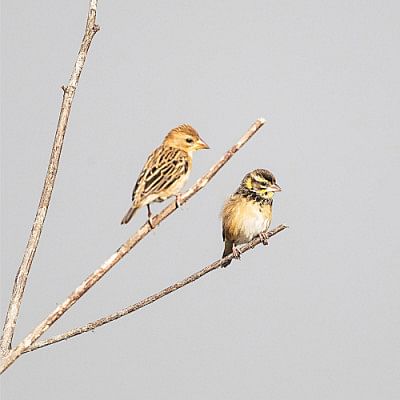Weavers

Weaver birds are nature's engineers. They build intricate nests from vegetable material such as grass, leaves and palm fronds. Most weaver birds are found in Africa with a few in South Asia and Australia. They belong to the Ploceidae family of birds which has over 120 species.
In Bangladesh we have three species of weaver birds: Baya Weavers, Black-breasted Weavers and Streaked Weavers. Of these, Baya Weavers are easiest to find. If you wander around the countryside in monsoon you can spot their nests hanging from Coconut or Shupari trees. Black-breasted Weavers are somewhat more difficult to find. It helps if you know where to look for them – for example, from other birders. Streaked Weavers are the rarest of our weaver birds and incredibly difficult to find. All three are about the size of a House Sparrow.
Starting in late spring, male Baya Weavers start building their nests which hang from high supports such as palm fronds. They use their sharp beaks to strip long threads from the fronds and tall grass and weave them together into a nest. Using their saliva as glue, they make distinctive, elongated nests 1-3 feet tall with openings either below or on the side. The male works hard to make the nicest possible nest and uses it to entice a suitable female to mate with. It also works very fast, sometimes finishing a nest in one or two days. The end result is functional and tidy.
Black-breasted weaver nests are also nicely constructed. They build them close to the ground, usually in the middle of tall grass. Being within easy reach of many predators, they choose well-hidden spots, so these nests are not readily visible like the nests of Baya Weavers.
Not all weaver nests are neat and tidy. In southern Madagascar I saw nests of Sakalava Weavers. They were huge, sometimes spreading over several trees. A dozen birds were working on the nest simultaneously. These weaver birds look similar to our Baya Weavers with the males sporting a yellow crest. Another weaver I saw in Madagascar was the Nelicourvi Weaver, which is more solitary. I saw its nests hanging from branches overhanging a canal in the forest. They were round, a little smaller than a football, and made from vegetation threads that were coarser than the threads used by Baya Weavers.
Sociable Weavers are found in southern Africa. They are well-known for their large nests, which they build as much as ten meters high and which can contain hundreds of individual nest chambers – just like a large apartment building. These nests are a far cry from the Baya Weaver's nest and look more like a large pile of hay. Sometimes large snakes raid these nests for eggs or chicks.
For me, the best part about weaver birds is watching them build a nest. All around us, nature performs many miracles that we miss, either because they happen too fast, or too slow, or we don't understand them. Watching weavers at work, I find, is an easy and satisfying way to appreciate nature's wonders.
www.facebook.com/ikabirphotographs or follow "ihtishamkabir" on Instagram.

 For all latest news, follow The Daily Star's Google News channel.
For all latest news, follow The Daily Star's Google News channel. 



Comments